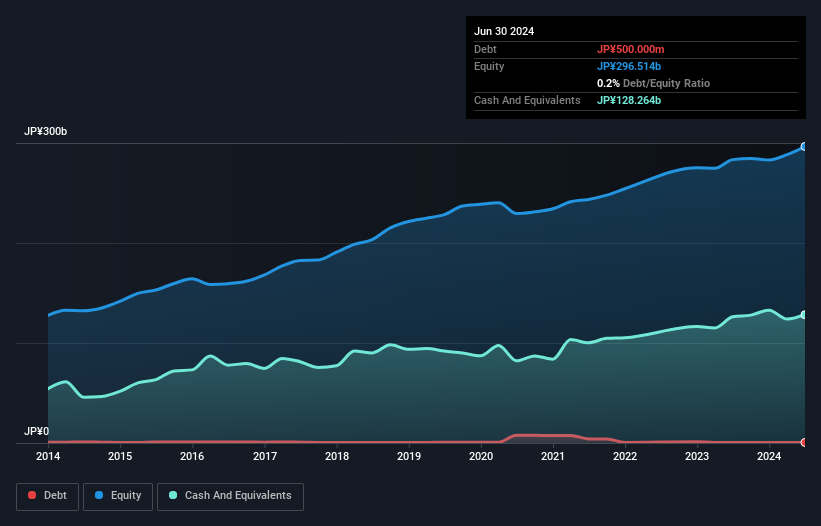Some say volatility, rather than debt, is the best way to think about risk as an investor, but Warren Buffett famously said that 'Volatility is far from synonymous with risk.' It's only natural to consider a company's balance sheet when you examine how risky it is, since debt is often involved when a business collapses. As with many other companies KOSÉ Corporation (TSE:4922) makes use of debt. But should shareholders be worried about its use of debt?
When Is Debt A Problem?
Generally speaking, debt only becomes a real problem when a company can't easily pay it off, either by raising capital or with its own cash flow. In the worst case scenario, a company can go bankrupt if it cannot pay its creditors. However, a more common (but still painful) scenario is that it has to raise new equity capital at a low price, thus permanently diluting shareholders. Having said that, the most common situation is where a company manages its debt reasonably well - and to its own advantage. When we think about a company's use of debt, we first look at cash and debt together.
Check out our latest analysis for KOSÉ
What Is KOSÉ's Net Debt?
The chart below, which you can click on for greater detail, shows that KOSÉ had JP¥500.0m in debt in June 2024; about the same as the year before. However, its balance sheet shows it holds JP¥128.3b in cash, so it actually has JP¥127.8b net cash.

How Strong Is KOSÉ's Balance Sheet?
We can see from the most recent balance sheet that KOSÉ had liabilities of JP¥64.3b falling due within a year, and liabilities of JP¥19.4b due beyond that. Offsetting these obligations, it had cash of JP¥128.3b as well as receivables valued at JP¥44.7b due within 12 months. So it can boast JP¥89.3b more liquid assets than total liabilities.
It's good to see that KOSÉ has plenty of liquidity on its balance sheet, suggesting conservative management of liabilities. Due to its strong net asset position, it is not likely to face issues with its lenders. Simply put, the fact that KOSÉ has more cash than debt is arguably a good indication that it can manage its debt safely.
In fact KOSÉ's saving grace is its low debt levels, because its EBIT has tanked 24% in the last twelve months. When it comes to paying off debt, falling earnings are no more useful than sugary sodas are for your health. The balance sheet is clearly the area to focus on when you are analysing debt. But it is future earnings, more than anything, that will determine KOSÉ's ability to maintain a healthy balance sheet going forward. So if you want to see what the professionals think, you might find this free report on analyst profit forecasts to be interesting.
Finally, while the tax-man may adore accounting profits, lenders only accept cold hard cash. While KOSÉ has net cash on its balance sheet, it's still worth taking a look at its ability to convert earnings before interest and tax (EBIT) to free cash flow, to help us understand how quickly it is building (or eroding) that cash balance. During the last three years, KOSÉ produced sturdy free cash flow equating to 78% of its EBIT, about what we'd expect. This free cash flow puts the company in a good position to pay down debt, when appropriate.
Summing Up
While it is always sensible to investigate a company's debt, in this case KOSÉ has JP¥127.8b in net cash and a decent-looking balance sheet. The cherry on top was that in converted 78% of that EBIT to free cash flow, bringing in JP¥8.8b. So we are not troubled with KOSÉ's debt use. Over time, share prices tend to follow earnings per share, so if you're interested in KOSÉ, you may well want to click here to check an interactive graph of its earnings per share history.
Of course, if you're the type of investor who prefers buying stocks without the burden of debt, then don't hesitate to discover our exclusive list of net cash growth stocks, today.
Valuation is complex, but we're here to simplify it.
Discover if KOSÉ might be undervalued or overvalued with our detailed analysis, featuring fair value estimates, potential risks, dividends, insider trades, and its financial condition.
Access Free AnalysisHave feedback on this article? Concerned about the content? Get in touch with us directly. Alternatively, email editorial-team (at) simplywallst.com.
This article by Simply Wall St is general in nature. We provide commentary based on historical data and analyst forecasts only using an unbiased methodology and our articles are not intended to be financial advice. It does not constitute a recommendation to buy or sell any stock, and does not take account of your objectives, or your financial situation. We aim to bring you long-term focused analysis driven by fundamental data. Note that our analysis may not factor in the latest price-sensitive company announcements or qualitative material. Simply Wall St has no position in any stocks mentioned.
About TSE:4922
KOSÉ
Manufactures and sells cosmetics and cosmetology products primarily in Japan and internationally.
Flawless balance sheet with moderate growth potential.
Similar Companies
Market Insights
Community Narratives





